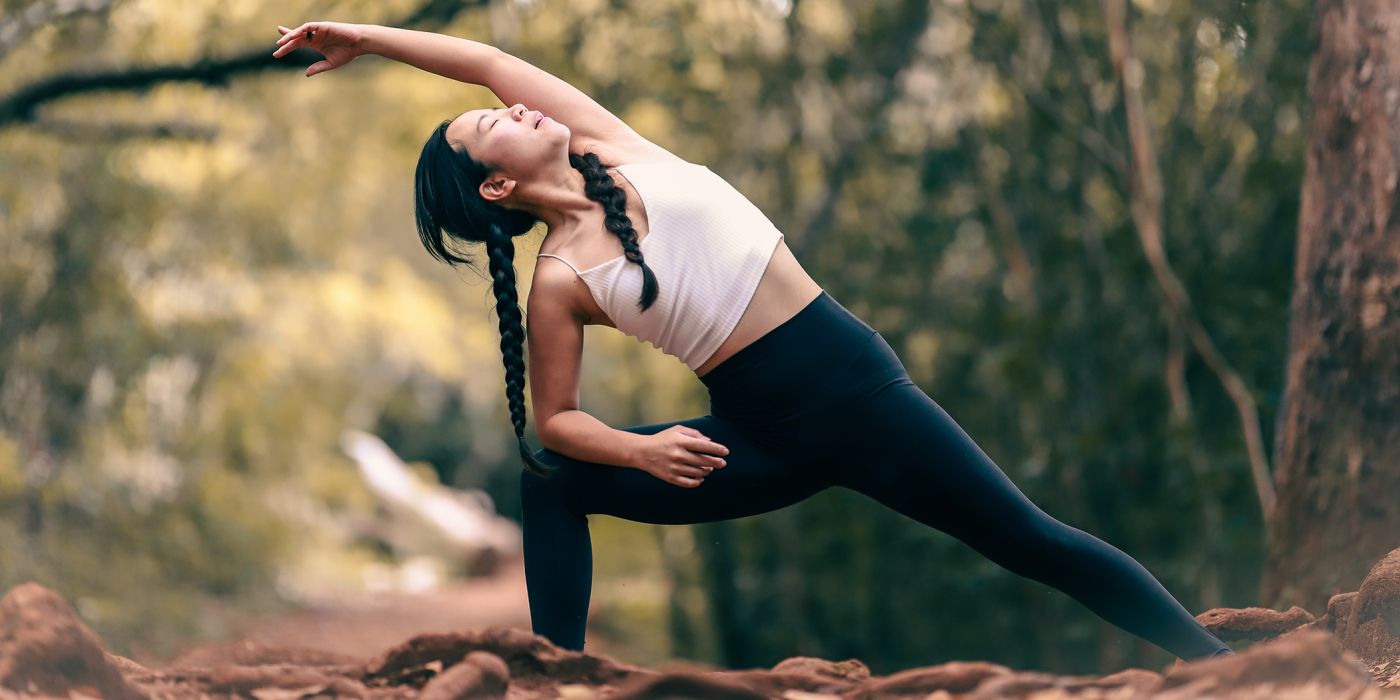Stretching in the Morning: Knees, Legs and Lower Back Stretches

Stretching is the act of placing different parts of your body into a position that lengthens and elongates the muscles and soft tissues.
Should I be stretching in the morning?
Stretching any time of the day is beneficial, however, it may be more beneficial for you to stretch in the morning. It can help to loosen tight muscles that may cause you pain throughout the day. You might feel more tension in the morning due to an increase of fluid in the joints.
When we are asleep, our muscles are relaxed and the blood flow decreases, and by laying in the same position throughout the night, your muscles tense and tighten. Therefore, stretching in the morning can cause an increase in blood flow, making your range of mobility much better.
What are the benefits of stretching in the morning?
In addition to stretching overall making us feel much better in the morning, it can aid the following benefits:
Mobility
If you wake stiff or your muscles feel tight, this is going to make it considerably harder to move around throughout the rest of your day. Stretching in the morning makes it easier for you to rid yourself of those aches and pain, making it much more comfortable to complete activities. It increases your mobility, and regular morning stretching can help to support your muscle coordination and allow your muscles to work together in sync for a better range of movement.
Stress Relief
Stretching can help to relieve physical stress as well as mental. If you are struggling with tense muscles in the morning, it may be due to physical stress that has been put upon your body. Stretching can help to relieve that stress and therefore put you in a much more relaxed state. This can have a great impact on your mental stress as feeling tense physically can contribute to this.
Posture
Whether you are stretching in the morning or throughout the day, it can be beneficial for your posture. If you are looking to incorporate it into your morning routine, concentrating on stretches that focus on your chest and back muscles will be most beneficial for your posture. Tense muscles are what lead to a bad posture, so by making your morning stretches a regular act, it can improve your posture.
Current aches and pains
If you are struggling with current aches and pains, they might feel tighter in the morning and feel more painful. However, stretching can ease the aches that you feel in both the muscles and the joints.
Flexibility
As we have explained, waking up in the morning can leave you feeling tense and tight, therefore stretching can help with your flexibility, which refers to the range of motion in your joint(s). Stretching can lead to an increased range of motion and thus increase your flexibility.
Benefits of stretching your knee
Your knees can be painful if they are tight or tense, making most important movements, such as walking and running, difficult. Stretching your knee and doing stretches that are designed to work the muscles of your knee can be extremely beneficial by providing relief. The following knee stretches are recommended by Healthline.
Knee Straighteners
This is one of the most simple stretches and it involves working the hips and knees. You can straighten your knee, which in the process loosens the surrounding muscles.
Straight Leg Raises
This is done in a similar motion to knee straighteners, but the knee is extended and this stretches the tendons and the muscles that are behind the joint of your knee.
Standing Quad Stretch
This involves standing on one foot, which you can alternate, and grabbing your opposite shin and bending the leg behind you. This loosens the muscles and the tendons in front of your knee, stretching the front of your thigh.
Seated Hamstring Stretch
This stretch involves the use of chairs and involves sitting on one chair and elevating your leg on the other chair, allowing the stretch of your hamstring and relieving pressure from the knee.
Ensure that you do not overwork any of the stretches listed above and listen to your bodies response to the stretch.
Stretching to relieve back pain
Back pain can become a menacing part of life, with a stiff neck, back and shoulders all contributing. If you are looking to work these parts of the body, then the following stretches recommended by Spine-Health are aimed to relieve such pains.
Chin to Chest
Focus on smoothly bending your head forward by bringing your chin in toward your chest until you feel the stretch in the back of your neck.
Ear to Shoulder
This stretch involves bending your neck side to side so your ear touches each shoulder where the stretch is felt in the opposite side of your neck. Ensure good posture for the stretch.
Corner Stretch
This stretch involves standing and facing the corner of a room. Place your forearms against the wall at shoulder height and lean forward until you can feel a stretch under the collarbone.
Levator Scapula Stretch
Start by resting one of your arms against a wall slightly above shoulder height. Turn your head to face the opposite direction of your arm, bringing down your chin to feel a stretch under the collarbone and the back of the neck.
Stretches for the back
Back Stretch
This stretch involves laying down on your back and pulling both of your knees towards your chest and bringing the head forward until you feel a comfortable stretch in your mid-back.
Knee to Chest Stretch
Once again, lie on your back and bend your knees so that both of your heels are firmly on the floor. Place both of your hands behind one of your knees and bring it forward towards your chest.
Kneeling Lunge Stretch
This starts by being on both knees, moving one of your legs forward so that your foot is flat on the ground. Place both of your hands on your thigh and lean forward, creating a stretch in the front of the other leg.
Benefits of stretching your legs
If you are wanting to stretch as part of a workout routine to increase your flexibility or painful muscles, then stretching your legs can be a great addition to your morning stretches.
Hamstring/Calf Stretch
This works the muscles in the upper part of the leg and contributes to bending and movement. Extend your foot in front of you (these can be alternated) and bend at the waist bringing your torso forward toward the extended leg. Flex your ankle so that the toes are pointing towards you.
Inner Thigh Stretch
Start by standing with a wide stance and bend one knee (alternating) and shift the body until a stretch is felt in the inner left thigh. This works the hip and strengthens the muscles in your leg.
Stretching Upper Trapezius
The trapezius refers to the shoulder girdle that is responsible for rotating the shoulder blaze, the stability of the arm and extending the neck. It is a busy muscle and this can sometimes cause tension. The best method to loosen this muscle is through the process of neck and shoulder stretches.
The Crocodile Pose
This is a starter pose and involves laying down on your stomach, ensuring that your feet are shoulder-width apart and resting your hands one on top of the other and placing them under your chin. Rest your forehead on top of your hands and rest, releasing the tension.
Cobra Pose
This is a great stretch for releasing tension in the lower back in addition to the trapezius. To start, lay on your stomach and lift your head, placing your hands on the floor next to your shoulders. Slowly lift your head and your chest off the floor, straightening your arms and arching your back.
Cat-Cow Pose
Start on all fours and lift your chest and head arching your back and then letting your belly fall. For the trapezius specifically, you want to focus the attention on the area between your upper shoulder blades, arching and releasing your neck.
What about stretching before bed?
Stretching before bed can be useful in its ability to aid such bedtime routines, such as yoga, meditation and mindfulness. According to Medical News Today, research suggests that stretching can reduce symptoms of insomnia and can improve the quality of your sleep.
Additionally, it may help you to relieve the aches and pain that you feel in the morning. If you are sleeping with tense muscles due to the daily activities, this can cause more pain to develop overnight. It can be a great way to release tension and wind down in the evening.
Here are some bedtime stretches to try. Complete them at least thirty minutes before you prepare to go to sleep, giving your muscles time to relax.
Bear Hug
This is an easy stretch and involves standing with your feet hip-width apart and crossing one arm over the other arm at the elbows and grasping your shoulders. Pull the shoulders forward and hold. Alternate the arms and feel the stretch in your upper back.
Head Roll
Stand straight with good posture and bring your chin down toward your chest and roll the head to the right and then to the left, alternating an ear to shoulder movement.
Seated Forward Bend
Sit on the floor with a good back and neck posture, and extend your legs out in front of you. Keep the legs straight and do not bend the knees. Bend as far as you can within a comfortable limit and reach towards your ankle and toes with your toes pointed up towards the sky.
Stretching Psoas
The psoas is a muscle that is located in the pelvis region that connects the lower back to your upper thigh. Having tightness or tension in this muscle can cause pain and problems with your everyday mobility. If you are struggling with pain in your hips, lower back, buttocks, leg or groin, then it is possible that you need to work this muscle. This can be done with the following stretches as suggested by Healthline.
Standing Pelvic Tilt
This is a very simple starter stretcher and involves standing up straight with good posture and pushing your pelvis back. You will feel the stretch in your abdominal muscles and your buttock. Hold for around 5 seconds and then release.
Kneeling Lunge Stretch
The easiest way to begin this stretch is by being on all fours and putting one foot through your hands so that your ankle is under the knee and the foot is flat on the floor. Bring your torso up and reach one arm up and bend to the side.
Walking Lunge Stretch
Stand with your feet around hip-width and place your arms by your sides. Keeping your posture, take a big step forward with one foot (alternate) and lower your body until your opposite leg is at a 90-degree angle. Hold and then release by putting the focus on your hips and returning to the standing position.
Bridge Stretch
The stretch starts in a laying position, where you should be on your back, knees bent and feet flat on the floor. Place your palms on the surface of the floor and lift your hips until they are in line with both your knees.
Why stretching is important
Stretching should be an important part of everyday life. It ensures that the muscles are kept flexible, strong and healthy. If you lack stretches, it causes the muscles to shorten and become tense, which makes the use of these muscles much more difficult. This can then progress onto issues such as muscle damage, joint pain and strains.
If you currently do not stretch, but you want to start, it may be a good idea to start on some of the more simple stretches as you do not want to pull a muscle by overdoing it. Additionally, a good place to start is the shoulders, neck, lower back and legs.
I do hope you have enjoyed this article and hope that you will subscribe to my newsletter so you can get the latest information about all things naturally relaxing.
Stay in touch, join the Naturally Relaxing Newsletter
Newsletter Signup
Post Your Comments
or post as a guest
Be the first to comment.
Latest articles in Relaxation

Capturing the Perfect Sunset: Tips and Techniques

The Benefits of Aromatherapy: Essential Oils for Relaxation

Embracing Calm: Innovative Ways to Relax in the New Year

Autumn Aromatherapy: Essential Oils for Relaxation

Embracing Autumn's Tranquillity: Finding Peace in the UK's Golden Season






